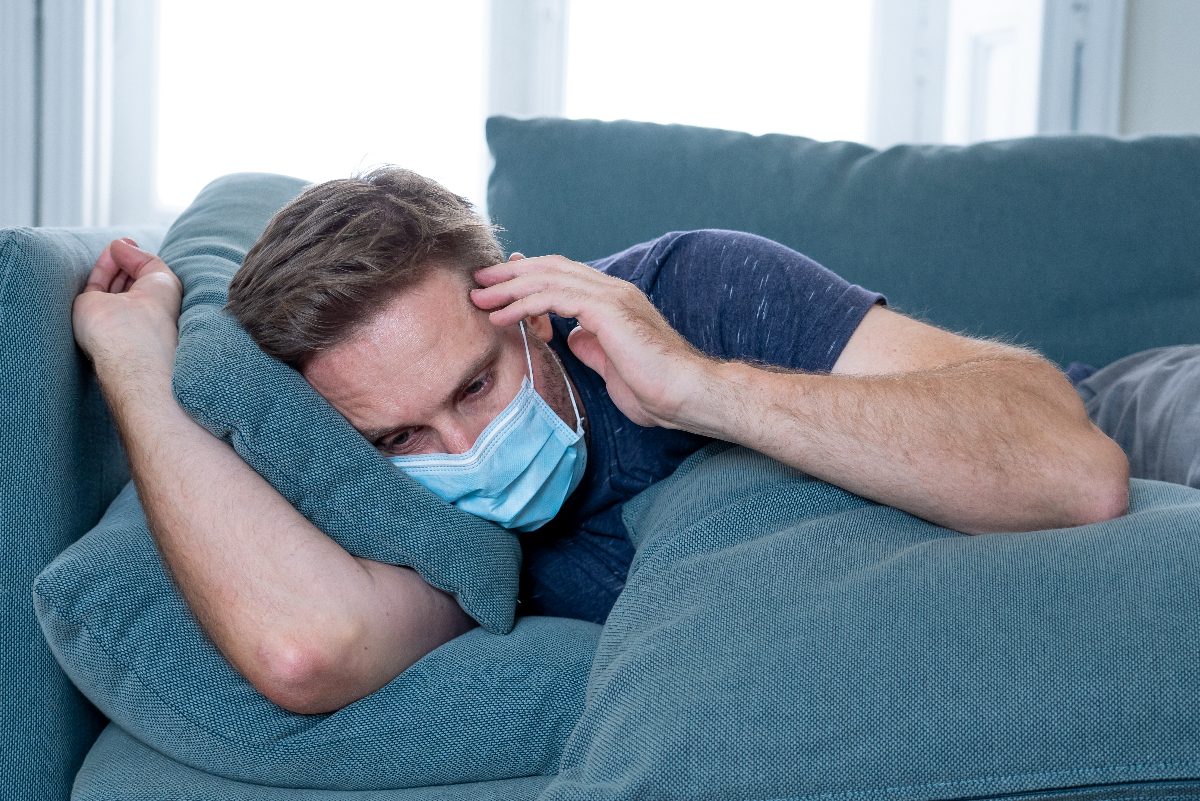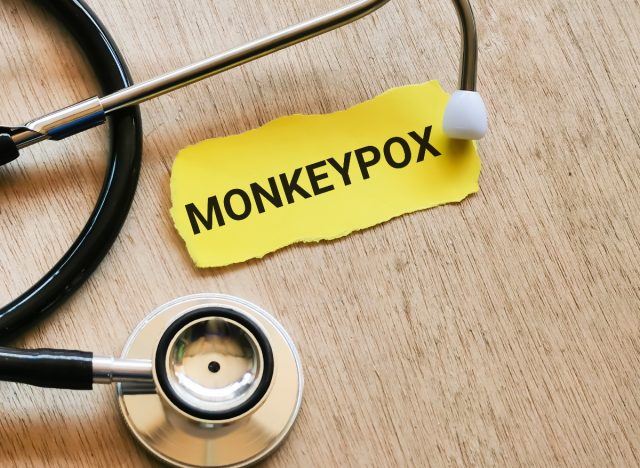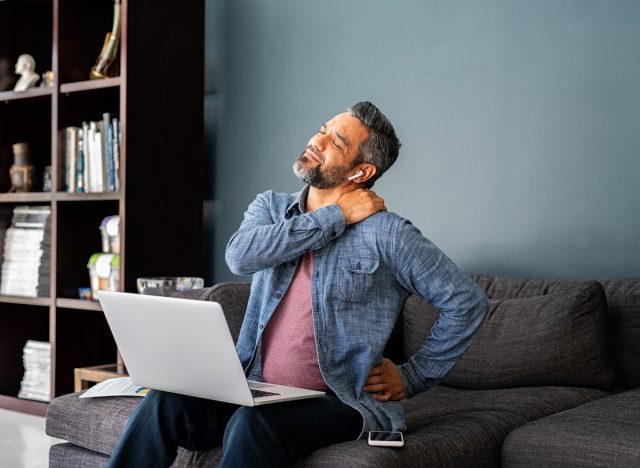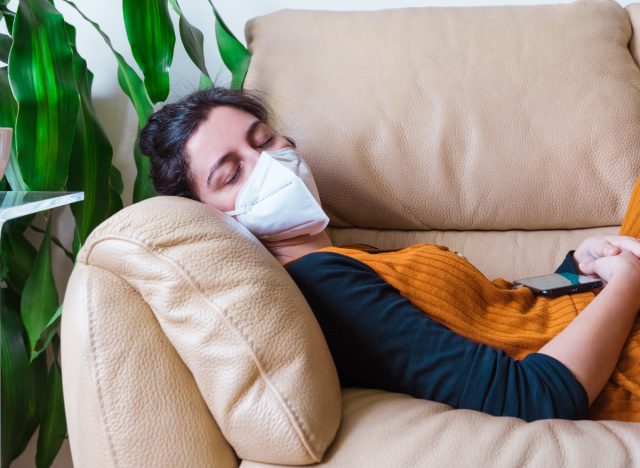What Is Monkeypox? Here’s What You Need To Know

The world has just started to get back to normalcy after experiencing a worldwide pandemic, and now we’re hearing news of yet another disease known as monkeypox. You’re probably wondering, “What is monkeypox, what are its symptoms, and should I be worried?” You’re also likely curious about whether or not you’re at risk of contracting the disease. WHO reports it’s not currently concerned about monkeypox becoming a pandemic, although “the situation is evolving and changing very rapidly.”
Eat This, Not That! spoke with Valerie E. Cadet, PhD. with PCOM Georgia, and here’s everything you need to know about monkeypox from its symptoms to isolation to treatment. Read on to learn more, and next, check out The 6 Best Exercises for Strong and Toned Arms in 2022, Trainer Says.
What is monkeypox?

Closely related to smallpox (a human virus that has been eradicated), Cadet tells us that monkeypox is an infectious disease caused by a virus that has the same exact name. Monkeypox is not as intense as smallpox, and it’s typically found in parts of Central and Western Africa. The disease has actually been observed for decades, even prior to the first case in a human that occurred in 1970.
Cadet explains, “The virus can naturally be found as a reservoir in small rodents such as rats and squirrels as well as monkeys in areas where it’s endemic.”
Related: Surprising Ways a Clean Home Can Impact Your Health, Expert Says
Keep an eye out for a headache, muscle and back pain, a fever, and a blistering rash

Symptoms typically start within seven to 14 days after being infected. However, some individuals can experience symptoms starting as soon as five days after they are exposed, or it could take up to 21 days for symptoms to present themselves.
If you think you have been exposed, the symptoms that are characteristic of monkeypox disease include a headache, muscle and back pain, and a fever. Cadet adds, “Someone infected would likely also have swelling of the lymph nodes, chills and be extremely fatigued as well. The most characteristic symptom [of] this disease is the rash that starts within a few days of the fever.”
Until recently, it has been known that the rash usually starts on one’s face, then spreads to other areas of the body. This may include the soles of the feet and palms of the hands. Various kinds of blisters will appear on the rash area, which will be pustules and vesicles that are filled with fluid. These blisters will turn into scabs, and normally in three to four weeks, they will fall off.
According to Cadet, there’s no need for concern, as monkeypox disease is typically not very severe, although it can last up to about a month. Historically, in some outbreaks, up to 10% of infected individuals can die, she says. Notably, in the 2003 outbreak in the United States, there were no mortalities whatsoever.
The good news of this horrible-sounding infectious disease? Cadet tells us, “Generally, despite the seriousness of the disease, the prognosis is good and the disease is usually self-limiting.”
Related: The Ugly Side Effects of Seasonal Allergies, Expert Says
This is when you should seek the help of a medical professional and self-isolate

“Anyone who has developed both a rash and fever without a certain cause should immediately self-isolate and contact their local or state health department,” Cadet says. “If someone develops some of the other symptoms without fever or rash they should contact their physician for evaluation and further guidance.”
Currently, the United States does not require individuals infected with monkeypox to quarantine. The Centers for Disease Control and Prevention (CDC) has recommended isolation precautions for infected individuals who are not hospitalized—they can be seen on the CDC’s website.
Cadet stresses, “Specific decisions regarding how long and when to discontinue are made in consultation with local health officials on an individual basis.” In general, infection precaution and isolation procedures in your home would involve having the person who is in isolation wear a surgical mask, practice good hand hygiene, use disposable gloves, and wash all bedding and laundry separately using warm water with detergent. Also, dirty utensils and dishes should be washed in hot water and dish detergent, or in a dishwasher. Anyone in the home should also consider wearing disposable gloves and a surgical mask when in contact with the individual who has monkeypox.
The way to treat monkeypox at home is really with supportive care. Cadet advises, “Treating the fever with acetaminophen or NSAIDs, for instance. Though there aren’t any FDA-approved treatments for monkeypox specifically, antivirals and other drugs approved to treat smallpox, vaccinia complications (a related poxvirus) or certain complications in AIDS patients may prove beneficial in treating monkeypox.” She adds, “There is an FDA-approved vaccine for smallpox and monkeypox that can be administered post-exposure within four days to prevent disease development and if given between five and 14 days after exposure, it can decrease severity of symptoms, leading to more mild disease.”
Monkeypox seems to be spreading predominately through contact with contaminated clothes, bodily fluid, or pus from blisters

If you believe you have been exposed and/or have symptoms indicating you may have monkeypox, it’s imperative that you contact your local or state health department officials and your physician immediately.
According to Cadet, “It is expected that there will be more cases so we should all know the symptoms to look for, however, the monkeypox virus doesn’t spread as readily as other viruses such as SARS-CoV-2. In this case, it requires prolonged close contact in order for respiratory spread to occur, and in the case of the current outbreaks that we are seeing over this last month, it appears to be spreading predominantly through contact with bodily fluids, pus from the blisters and clothing or other items that have become contaminated with those fluids.”
Cadet warns that in a nutshell, all individuals should take the necessary precautions when in contact with anyone with “a flu-like illness” with the rash described above and swollen lymph nodes. “The scabs themselves are still extremely infectious,” Cadet says. “Take home: the virus enters through breaks in the skin (even microscopic breaks), respiratory tract and mucus membranes such as the eyes, nose and mouth.”
Individuals born in the U.S. prior to 1972 or elsewhere in the world until about 1980 likely received the smallpox vaccine. The good news is that vaccination could protect you from contracting monkeypox, too. The bad news? A good majority of Americans younger than 50 years of age are probably not vaccinated or immune to the disease. Because of this, everyone should use caution by limiting their exposure and potential to transmit the disease.









